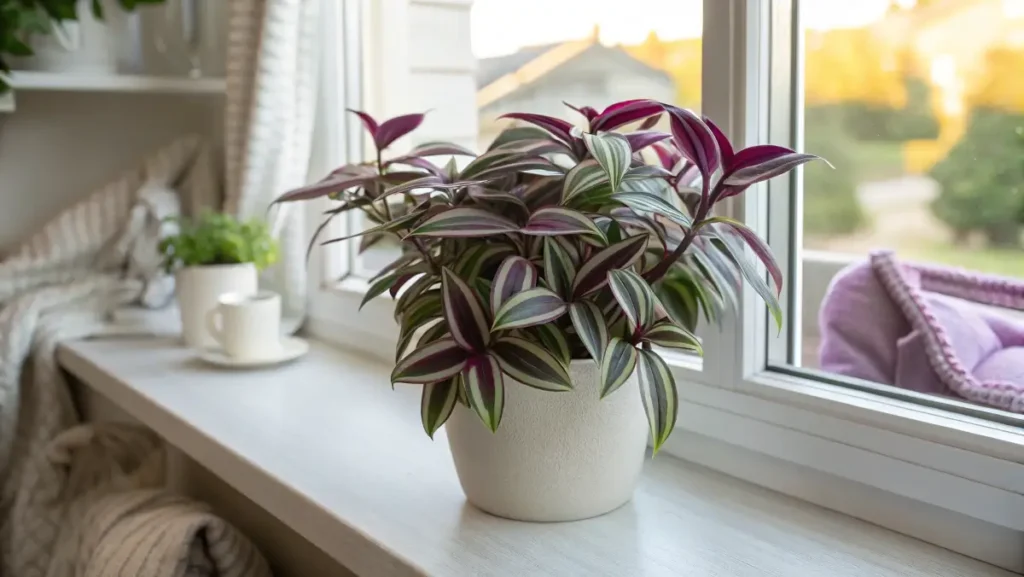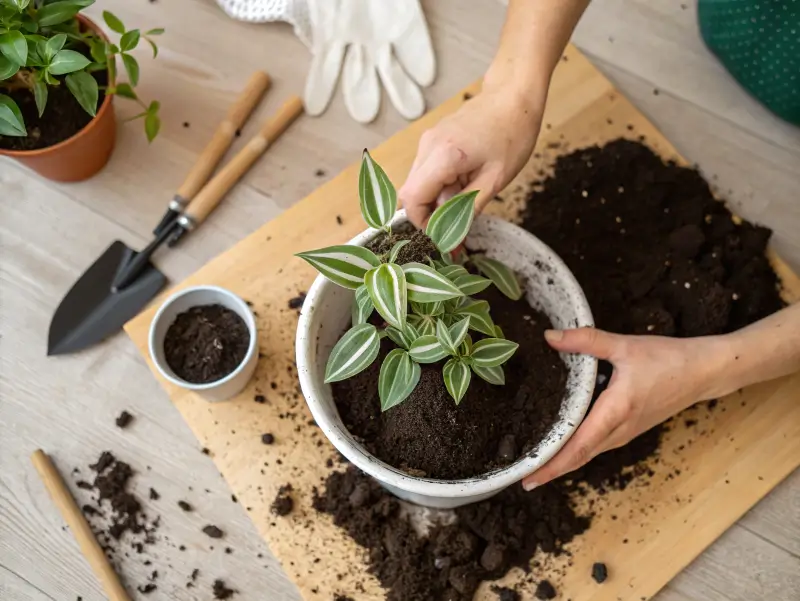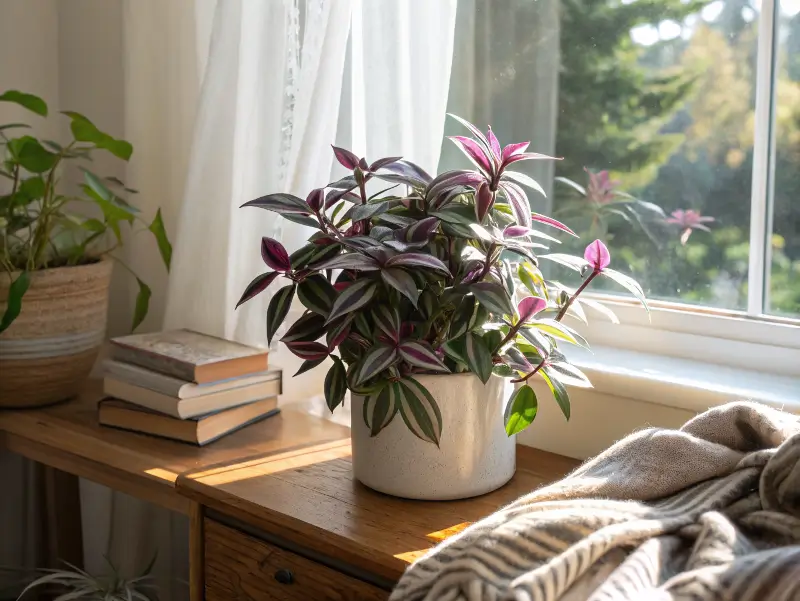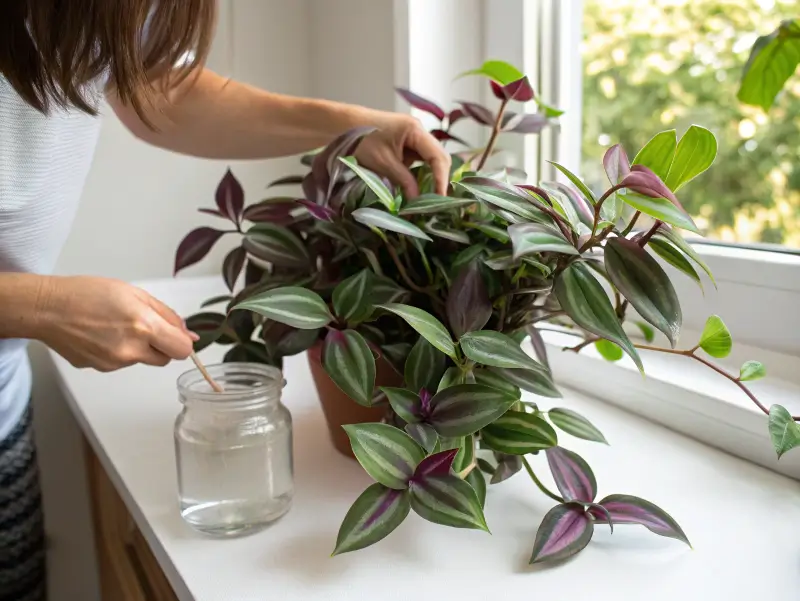
I’m excited you joined me today to discuss wandering jew plant care. This blog post covers everything I’ve discovered—like choosing the right potting mix and watering tips. Many people adore these ornamental houseplants, thanks to their bright leaves, relaxed spirit, and trailing charm. You’ll learn simple steps for top-notch maintenance so your plants thrive indoors. If you’re like me and love quick, green therapy, stick around. Let’s jump right in!
Table of Contents
Introduction to the Wandering Jew Plant
Origin and Varieties
I first spotted a Tradescantia Zebrina years ago at a local farmers’ market. Those shimmering, purple-and-green leaves captured my heart in an instant.
- These plants basically belong to a family that includes names like Inch Plant, Spiderwort, and Wandering Dude.
- While colors differ, many share similar demands: warm temperatures, moderate light, and consistent water.
- They’re originally from Central and South America, so they appreciate a touch of humidity.
The awesome part is that wandering jew plant care doesn’t require a fancy greenhouse. All you need is the right balance of water, light, and warmth. In my opinion, even plant newbies can do well if they follow a few simple tips!
Why It’s Popular Among Houseplant Enthusiasts
Walk into almost any houseplant collection, and you’re likely to spot a vibrant Tradescantia. The large group of easygoing plants has a few perks:
- Stunning Appearance: Striped leaves that range from green, purple, or white.
- Easy Care: Adapts to various indoor environments with little fuss.
- Rapid Growth: You can see new leaves popping out within days if it’s happy.
I adore hanging these plants near sunny windows because they trail so gracefully. When folks visit, they often ask, “Wow, how did you get it to look so full?” Trust me, a little attention goes a long way with wandering jew plant care.
Understanding wandering jew plant care Requirements
Ideal Climate and Conditions
For wandering jew plant care, a reliable environment matters. These guys love cozy indoor temperatures. Try to maintain:
- 65°F to 80°F (common indoor range)
- Slight humidity if possible
- Good airflow to prevent mold or fungus
I keep mine away from chilly drafts near windows, especially in colder months. If your climate is mostly warm, you can even keep them outside in partial shade. Just watch them closely when summer hits its peak!
Common Names and Synonyms (Tradescantia, Inch Plant, Spiderwort)
When shopping, you might see these labeled differently:
- Inch Plant
- Spiderwort
- Tradescantia Zebrina or Pallida
- Wandering Dude
All these names point to similar care routines. I pair them with other shade-loving houseplants, such as the Curly Lipstick Plant, to create an interesting foliage combo. If you’re nuts about color variation, you’ll have a blast exploring all the Tradescantia species out there.
Soil & Potting Mix for Healthy wandering jew plant care

Best Soil Types and Ingredients
A proper potting mix is vital. In my own wandering jew plant care journey, I learned that waterlogged soil is a big no-no. Aim for a well-draining blend:
- Standard indoor potting mix
- Added perlite or coarse sand for drainage
- A touch of organic matter (compost or worm castings)
This helps maintain moisture but prevents sogginess. If your soil gets soupy, you might see your plant’s leaves growing limp or dropping off.
Choosing the Right Container
A container with a drainage hole is the way to go. Here’s why:
- Excess water can escape quickly, protecting the roots.
- Terracotta or clay pots allow moisture to evaporate, reducing the risk of root rot.
- Plastic pots are also fine if you water sparingly.
Keep your pot size appropriate for the root system. Going too big too fast can cause water to linger in pockets where the roots aren’t developed, leading to problems. Smaller steps are safer in achieving successful wandering jew plant care.
Watering Schedules & Humidity: Key to Thriving wandering jew plant care
How Often to Water & Signs of Overwatering
Watering can feel like a dance, right? Too much and you risk mushy stems; too little and you get wilting leaves. My personal approach:
- Water once the top inch of soil feels dry.
- Reduce frequency in cooler months.
- Watch for droopy leaves (often means thirst) or yellowish, mushy leaves (too much watering).
I still use the fingertip test—just stick a finger in the soil to see how moist it is. That simple step saved me from overwatering more times than I can count!
Humidity Levels and Misting Techniques
Since Tradescantias come from tropical areas, they enjoy a bit of humidity. You don’t have to create a steam room, but you can try:
- A small humidifier nearby
- A pebble tray with water beneath their pot
- Misting leaves occasionally
Misting feels relaxing, but watch out for excessive mold or mildew. Good airflow will keep the leaves clean. Honestly, in my home, I aim for a moderate approach by partially opening windows on warm days and letting breezes flow in. That’s been enough to keep them content!
Light Requirements: Full Sun vs. Shade

Does the Wandering Jew Like Full Sun or Shade?
Many gardeners wonder if wandering jew plant care calls for direct sun or deep shade. The quick answer: something in-between. Ideally:
- Bright, indirect light
- Some morning sun is okay
- Avoid intense midday rays right on the leaves
Too little light dulls the vibrant stripes. I’ve placed mine near a window with sheer curtains. That way, they get a gentle beam of sun without scorching.
Positioning Tips Indoors & Outdoors
Indoors, a bright windowsill or a slightly set-back shelf from a sunny window works best. Outdoors, choose a spot with dappled sunlight or partial shade. One tip that helped me:
- Rotate the pot every few weeks so each side gets an equal amount of light.
- Observe leaves often; limp or pale growth can indicate low light, while crispy edges might mean too much sun.
By doing this gentle rotation routine, I keep the color patterns strong and symmetrical.
Indoor wandering jew plant care
Temperature and Light Adjustments
Indoor environments can be comfy for most houseplants. With Tradescantias:
- Maintain 65-80°F
- Avoid fluctuating temps (like near AC vents)
- Provide bright, indirect light year-round
Because the sun’s angle shifts with the seasons, the perfect window in winter might become intense in summer. I move mine a bit away from the window come July or August to prevent leaf burn. A smidge of mindful repositioning can keep your plant thriving.
Common Indoor Care Mistakes to Avoid
I’ve goofed a few times on wandering jew plant care. These are the biggest pitfalls:
- Overwatering: Probably the most common error. Let some dryness form on the topsoil before each watering.
- Low Light: Leads to drab, leggy stems.
- Ignoring Pests: Check for spider mites, aphids, and mealybugs, especially under leaves.
- Skipping Fertilizer: During growth seasons (spring and summer), a balanced fertilizer once a month can keep them colorful.
A small effort in routine checks will help you catch issues before they spiral.
Pruning, Pinching & Propagating for a Bushy Wandering Jew

Importance of Pruning and Pinching
If you’ve seen lush Tradescantia pots overflowing with foliage, it’s often because someone gave them regular haircuts. Snip any leggy or straggly stems:
- Encourages branching and more leaves
- Maintains an attractive shape
- Removes any dead or damaged bits
Use clean scissors or pruning shears, cutting just above a leaf node. This will nudge the plant to produce new shoots. If you’re wanting that bushy look, pinching is gold in wandering jew plant care.
Making Your Wandering Jew Bushy Through Propagation
Propagating new plants is a fun way to multiply your collection:
- Snip a healthy, 4-inch stem just below a node.
- Remove the lower leaves.
- Place the cutting in water or directly into moist potting mix.
- After roots form, transplant into its own pot or place it alongside the parent for a denser effect.
I also place new cuttings next to a Spider Plant for a dynamic “mini-jungle” vibe. Merging different houseplants on a windowsill can bring some tropical flair indoors.
Common Issues & Solutions in wandering jew plant care
Dealing with Pests and Diseases
These plants aren’t super pest-prone, but creepers happen. Top troublemakers include:
- Spider mites: Look for fine webbing under leaves.
- Aphids: Tiny green bugs clustering on new shoots.
- Mealybugs: Cottony spots near nodes.
If you spot any, wipe leaves with a mild soapy solution or dab them with neem oil. For official suggestions, you can check resources from the USDA on controlling household pests. Also, keep the soil from staying constantly damp to avoid root rot. A sprinkling of airflow does wonders for wandering jew plant care.
Troubleshooting Leggy Stems and Brown Leaves
If your plant is leggy, it might be chasing light. Try these adjustments:
- Move it closer to a well-lit spot.
- Pinch back long stems for denser growth.
- Rotate it frequently to balance sun exposure.
Brown leaf tips can signal dryness or salt buildup. You can flush the soil under running water to remove mineral residue or tweak your watering schedule. Little changes often bring the leaves back to their vibrant purple-and-green glory.
FAQs on wandering jew plant care
Does Wandering Jew Like Full Sun or Shade?
Honestly, they want bright ambient light. Full, direct sun can be too harsh, and full shade might lead to dull colors. Think filtered sun or a cozy spot by a bright window.
How Do You Care for a Wandering Jew Plant Indoors?
- Keep temps around 70°F.
- Set it near a window with filtered light.
- Water once the topsoil feels a bit dry.
- Fertilize monthly in spring and summer.
- Check for pests and rotate the pot now and then.
How to Make Wandering Jew Bushy?
Pinch the tips! This redirects growth outward instead of just upward. You can also root cuttings back into the same pot, creating a thicker display.
How Often Should I Water My Wandering Jew?
It varies based on your home’s climate. As a rule:
- Once a week in warm seasons (if the soil dries out).
- Every 10 days or so in cooler months.
- Keep an eye on leaf texture to gauge dryness.
Conclusion & Final Thoughts
Recap of Key Tips
- Potting Mix: Well-draining soil with perlite or sand.
- Watering: Check soil moisture before each watering.
- Lighting: Bright, indirect sun is best.
- Temperature: Average indoor warmth suffices.
- Humidity: Moderate humidity or occasional misting helps.
- Pruning: Keeps plants bushy and healthy.
- Pests: Watch out for mites, aphids, or mealybugs.
These steps have helped me keep my Tradescantias in top shape.
Encouragement for Continued Green-Thumbing
Caring for these plants is a total joy. With vivid leaves, easy propagation, and a friendly growth habit, it’s no wonder wandering jew plant care is so popular. I love how the trailing stems jazz up my shelves and window ledges. Mixing them with other tropical housemates—like the Curly Lipstick Plant—brings that lush, jungle feeling to my living room.
Feel free to get creative with pot choices, fertilizer schedules, and location. With just a bit of trial and error, you’ll master wandering jew plant care and might even inspire your friends to join in. Happy planting, and thanks for reading along!

5 thoughts on “Wandering Jew Plant Care: Your Step-by-Step Guide & Tips!”
Comments are closed.